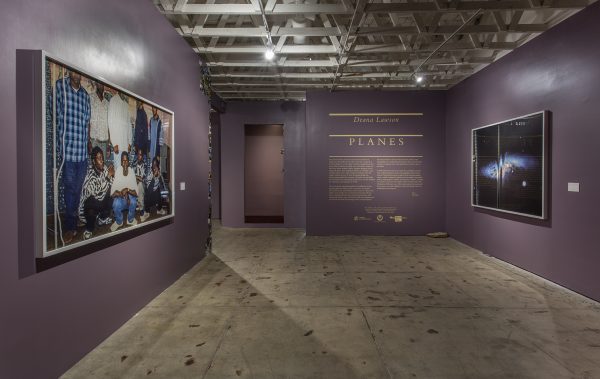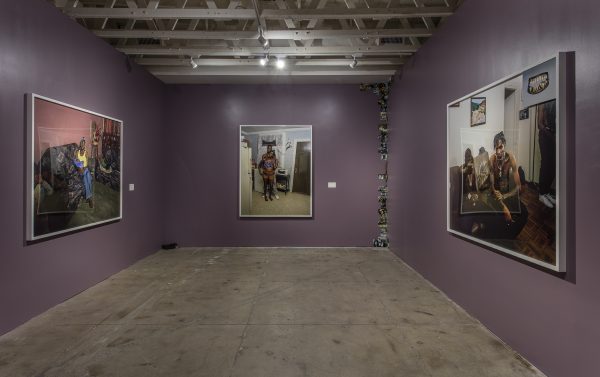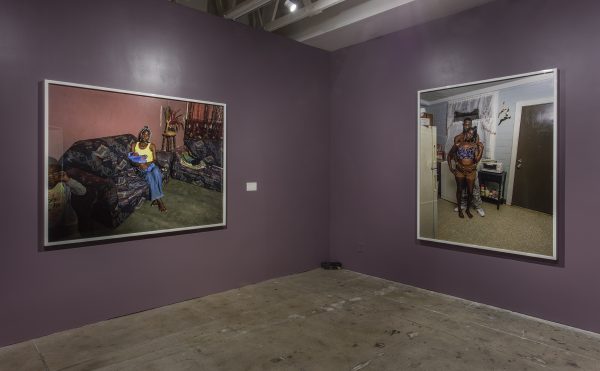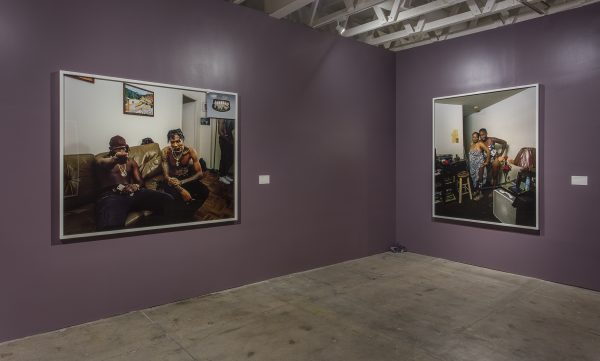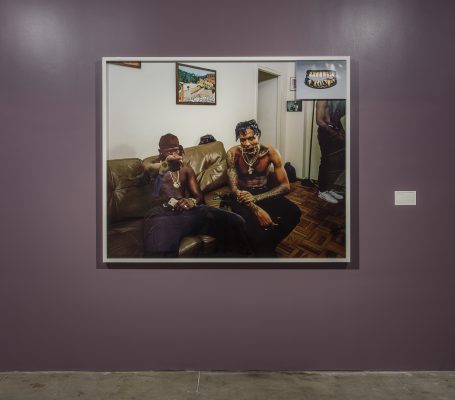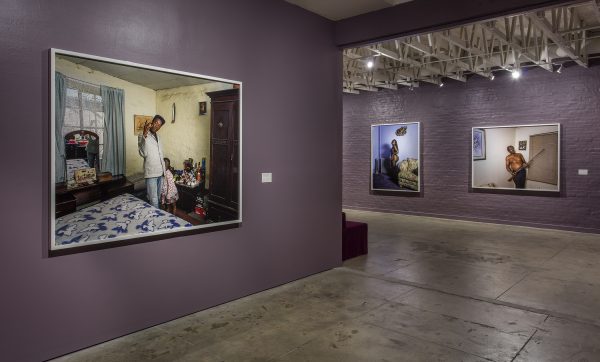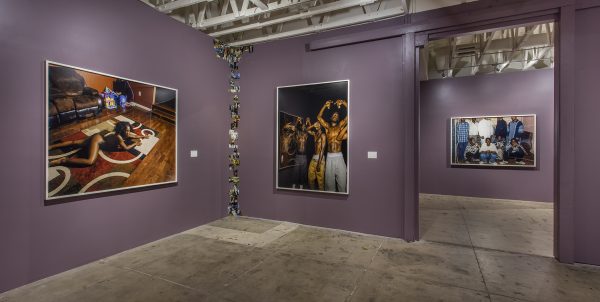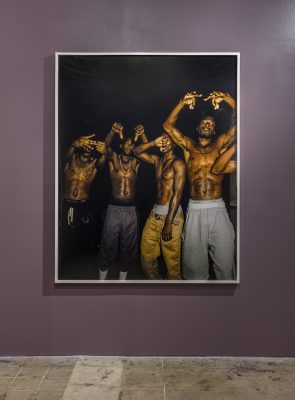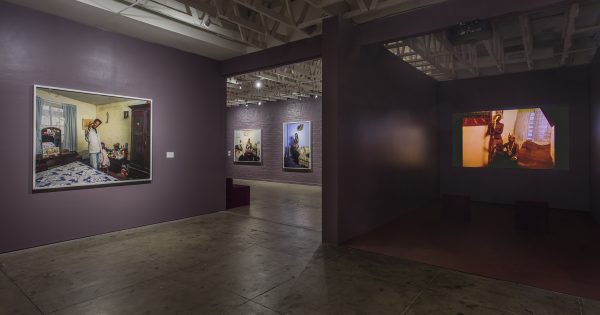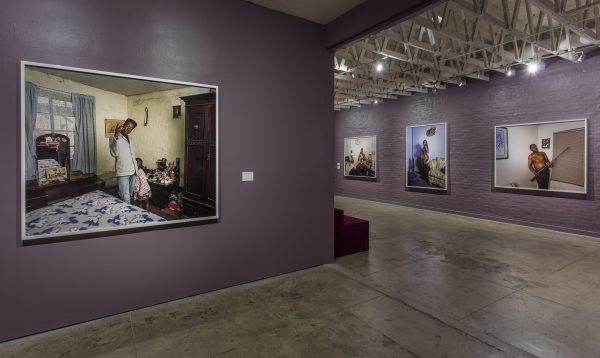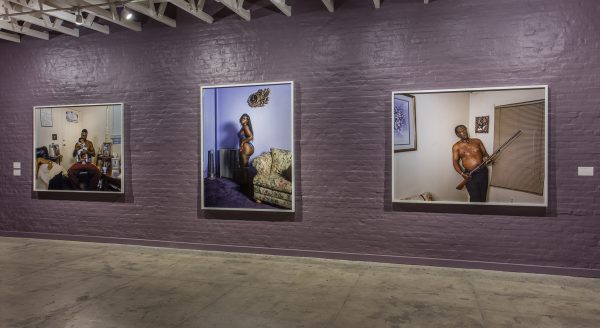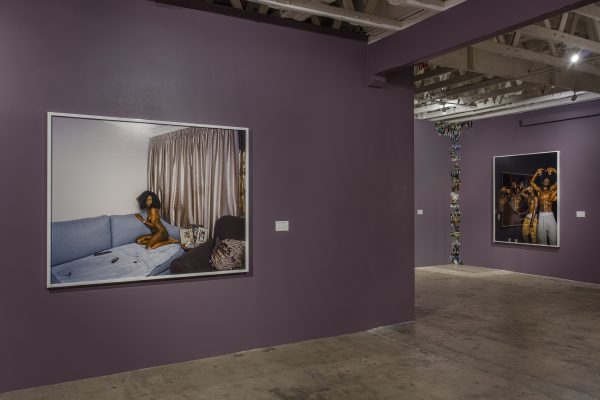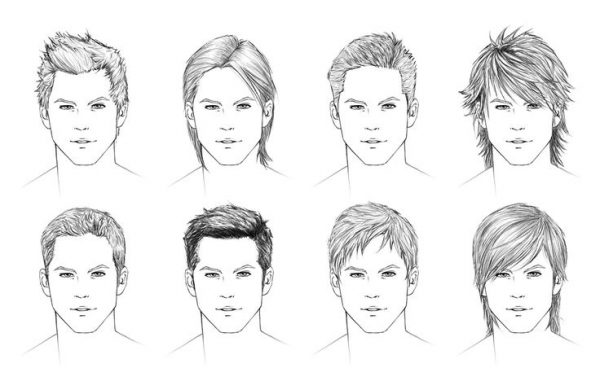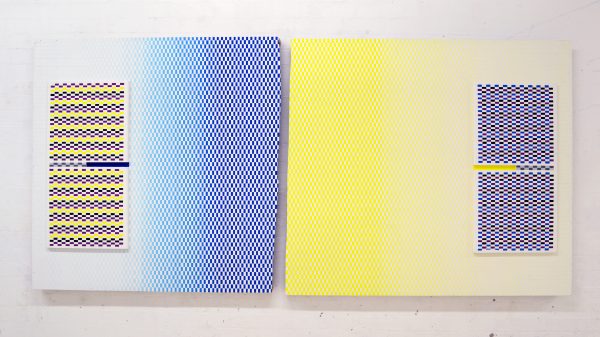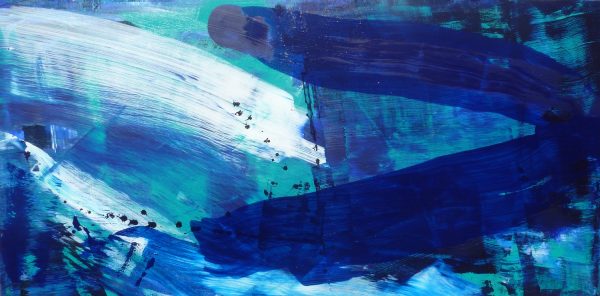At the Underground Museum in Los Angeles, radiant geodes have been placed in the corners for the safeguarding of Deana Lawson’s exhibition PLANES. In this city, the protective quality of crystals is accepted in the same way that lightbulbs are agreed to be sources of light. In certain corners, Lawson tacked up numerous 4 x 6 inch glossy prints: snapshots of her own younger self alongside scenes of atrocity, ritual, expedition and celebrity. Many of the images were scanned during her expansive research into black visual culture at American libraries. The assembled histories could be read as reports from a diasporic cosmology.
The collages also serve as the mood boards for Lawson’s own photographs, presented here as framed inkjet prints, each around four feet tall. They depict black people of various ages in staged domestic scenes. The models are often strangers to the artist and each other; the entwined man and woman in SEAGULLS IN KITCHEN (2017), for example, weren’t previously acquainted, and the brass birds that shadow them on the cinder block wall migrated there for the shoot. For WOMAN WITH CHILD (2017), the artist placed her own son alongside another woman as if he were a momentary changeling. At first, the images register as intimate family portraits, a testament to Lawson’s ability to disarm her subjects. Even the man holding a shotgun defensively in UNCLE MACK (2017) has a softness about his wizened face.
In these images, identity is both inscribed on bodies and articulated through their surroundings. The interiors, shot in New York, South Africa and L.A., appear underprivileged yet regal. Motifs recur: parquet flooring, bath towels on sofas, elephant statuettes, grandma curtains. (Zadie Smith has averred that ‘paragraphs could be written on Lawson’s curtains alone’.) Certain objects give the impression that other characters have vanished, or perhaps just wait in the wings: matriarchs out shopping, children put to sleep. In SOWETO QUEEN (2017), a nude woman crouches on a towel alongside remote controls, keys and a My Little Pony presumably brought there by her child, an absentminded offering.
The dignified eroticism of SOWETO QUEEN, as in many of Lawson’s works, recalls Audre Lorde: ‘In touch with the erotic, I am less willing to accept powerlessness.’ Not just models but the objects around them seem to wield agency as they pose in elegant resistance to what Lawson has identified in American culture as a decades-long assault on the black family. As she introduces foreign objects to the native bric-a-brac, Lawson flexes her authorship as much as documents identity. Compared with crystals, these are unlikely talismans, the kind of stuff that accumulates in a household to the point where no one who lives there sees it anymore. Plastic toys, latex gloves, a tub of Mini Chips Ahoy!, a vanity mirror with Belieber sticker: they take their place in compositions as with paintings like The Ambassadors (1533) by Holbein or van Eyck’s Arnolfini Portrait (1434), in which each prop is heavy with symbolic meaning.
In SONS OF CUSH (2016), two young men sit with an infant in the front room of a family home, surrounded by mementos. One has been cropped out except for his tattooed arm, assorted bling and the wad of cash in his hand. His companion is built, but has the wet eyes of a young boy. The baby in his grip, wearing a blue dress fit for baptism, gives renaissance attitude. On a whiteboard is sketched an outline of Africa and the patrilineage of Cush, grandson of Noah and father of Nimrod. The latter is said to have instigated the Tower of Babel, the hubristic endeavour that prompted God to disperse the earth’s people and confound their language. This aetiology suggests diffuseness of not just geography but meaning, raising questions about what these men have inherited, and what’s been taken along the way.
In staging these images, Lawson may draw from the lineage of African-American assemblage, what the painter Frank Bowling described as ‘that powerful, instinctive, and intelligent ability which Blacks have shown time and again, to rearrange found things, redirecting the “things” of whatever environment in which Blacks are thrown, placed, or trapped’. While artists such as David Hammons or Noah Purifoy have elevated ordinary objects through sculptural deliverance – fashioning greasy paper bags into wings or old television sets into an embankment, respectively – Lawson seems to arrive from the opposite direction. She hauls stuff home and puts it on the shelf as if that’s where it belonged. In her frame, the rooms appear majestic, even prelapsarian, but simultaneously chanced upon and lived-in.
Also on view in PLANES are found images which Lawson has enlarged to the size of her own, thereby giving equal prominence. In KINGS (2016), a group of young men in Saturday night best pose together with laid-back guile. Lawson cropped the photo where it was folded, so that most of one man’s head and parts of others are cut out. It would be easy to read this as a connotation of violence: we’ve become accustomed to regarding young black men in terms of their extinguishing. But Lawson’s title affirms their sovereignty. A second found image, shifting perspective cosmically, depicts the Messier 81 galaxy.
In Lawson’s provocative NATION (2018), three men are obscured to various degrees. One, wearing a du-rag, points at the camera, the gesture concealing his lower face. Another man’s mouth is prised open by an elaborate gold-painted dental implement. The third is blocked by a photo tucked into the frame, one of the artist’s rare manoeuvres external to the print. This intervening image is an archival document of George Washington’s dentures, which comprised – depending on the historian – wood or the teeth of horses and slaves. Lawson’s work finds dignity in half-disclosures. In NATION, she tackles a history of erasure and extraction with a visual idiolect that is head-on yet still obfuscates.
